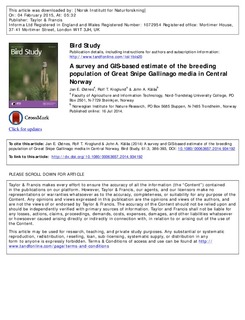A survey and GIS-based estimate of the breeding population of Great Snipe Gallinago media in Central Norway
Journal article
Permanent lenke
http://hdl.handle.net/11250/275658Utgivelsesdato
2014Metadata
Vis full innførselSamlinger
Sammendrag
Capsule By using a GIS-model to identify suitable breeding habitats for Great Snipe in Central Norway, weestimated a total of 276 leks holding approximately 2700 males.Aim To estimate the size of the Great Snipe population in central parts of the species remaining breedingareas in Western Europe.Methods GIS-analysis identified an area of 528 km2 as suitable habitat for Great Snipe in the total studyarea (22 000 km2). Complete surveys were made in 8% of these habitats by using a subset of 53 samplingareas.Results A total of 28 Great Snipe leks were found within the sampling areas. Ten of these were found inpreviously known lek areas, while 18 leks were found in areas with no previous knowledge of leks.Extrapolating the lek density and the lek size found in the surveyed areas, resulted in a total estimate of276 Great Snipe leks holding approximately 2700 lekking males. The leks were found on open fensalong the forest edge and were mainly situated on base-rich bedrocks. Mean altitude of the leks was570 m.Conclusion The total population of Great Snipe in Norway was previously assumed to comprise5000–15 000 lekking males or ‘pairs’. By extrapolating the densities of leks found in Central Norway toa national scale, we expect the true breeding population of Great Snipe to be approximately 13 500males. Changes in the elevation of the tree limit and increased overgrowth, as a result of reducedgrazing pressure and/or global warming, are possible threats that may reduce the availability ofpreferred Great Snipe habitats and increase population fragmentation.
Beskrivelse
-
